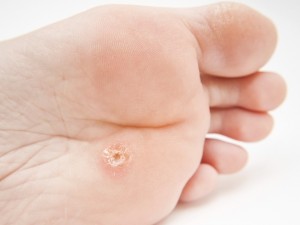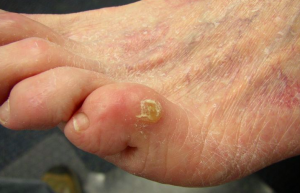 Corns are small, defined areas of thickened skin that can either be painless, or be a massive source of pain. They tend to be conical in shape, pressing into the deeper layers of the foot. There are three main types of corns:
Hard Corn – these are a compressed patch of hard, pale yellow skin with a dense core and are often present on the bottom, top or sides of the feet. These are medically known as Heloma Durum
Soft Corn – these tend to be found between the toes. They have a whiter and softer appearance, often having an indent in the centre. They are softer due to absorbing moisture into the skin, such as from sweat or not drying the feet after showering. These often occur between the 4th and 5th toes and are medically known as Heloma Molle
Seed Corn – these are much smaller and shallower than hard or soft corns, often likened to the size of a seed. Seed corns are tiny bumps that often occur on the bottom of the heel or ball of the foot. They may be painless or very painful. They often appear in clusters, though single seed corns also appear. These are medically known as Heloma Millare
Corns are small, defined areas of thickened skin that can either be painless, or be a massive source of pain. They tend to be conical in shape, pressing into the deeper layers of the foot. There are three main types of corns:
Hard Corn – these are a compressed patch of hard, pale yellow skin with a dense core and are often present on the bottom, top or sides of the feet. These are medically known as Heloma Durum
Soft Corn – these tend to be found between the toes. They have a whiter and softer appearance, often having an indent in the centre. They are softer due to absorbing moisture into the skin, such as from sweat or not drying the feet after showering. These often occur between the 4th and 5th toes and are medically known as Heloma Molle
Seed Corn – these are much smaller and shallower than hard or soft corns, often likened to the size of a seed. Seed corns are tiny bumps that often occur on the bottom of the heel or ball of the foot. They may be painless or very painful. They often appear in clusters, though single seed corns also appear. These are medically known as Heloma Millare
What causes corns?
Corns result from repeated focal pressure on the foot, such as rubbing of the skin against a shoe, wearing no socks with shoes, or foot deformities, to name a few. This means the longer you spend on your feet, the more likely you are to develop a corn. Altered foot shapes like bunions and clawed toes have a greater tendency to develop corns from the resulting friction with footwear. Women are more likely to develop corns due to wearing high heels and less supportive footwear than men. Corns are more prevalent with age as the skin thins and has less protection.What are the signs and symptoms?
Aside from circular white/yellow patches of skin on the foot, symptoms include:- Redness
- Tenderness
- Localised pain that can range from mild to severe
How do you treat corns?
 We safely and effectively remove most corns in the clinic. In most cases, this will alleviate painful symptoms immediately.
We safely and effectively remove most corns in the clinic. In most cases, this will alleviate painful symptoms immediately.
- The thickened, dead skin layers are trimmed back
- The corn is enucleated and removed
- As the skin is already dead, there is minimal pain (aside from the irritation from the corn)








